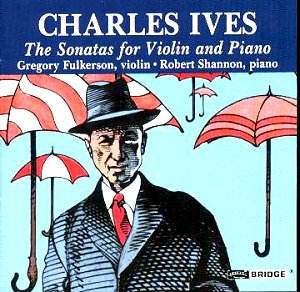Dating from between the years 1902-15 these four violin
sonatas are amongst the greatest of all Ives’ chamber works and present
the Ivesian aesthetic in all its radical and manifold complexity. The
juxtaposition of hymn tunes and the technical means open to him to explore
such material – clusters, polychords etc – give the sonatas a fruitful
tension, technical and expressive, that vests them with intense, frequently
speculative depth.
The intriguing canonic implications of the piano writing
in the first movement of the First Sonata serve notice of Ives’
seriousness; this movement is strong-willed, with violin light and piano
severe, quilted quotations stitched into the score and a magical return
to the opening theme. The violin enters the Largo cantabile second
movement muted, but the piano drives from piano to a strong forte, scraps
of tunes shed throughout – The Old Oaken Bucket, Tramp Tramp,
Tramp – whereupon the violin’s reminiscences are violently attacked
by the raging, torrential piano clusters for a brief moment before the
violin muses on. The final movement, a longish Allegro, opens with the
piano in rather martial fashion and the violin correspondingly pliant;
the violin becomes increasingly lyrical, with a sense of syncopation
never far away and rhythmic displacements ever possible. The close of
the work is one of elegiac serenity, with an extreme diminuendo from
Fulkerson – highly effective – and beautifully simple, spaced chords
from Shannon’s piano. The Second Sonata had an even slightly
longer gestation period, dating from 1902-09. The opening movement,
Autumn, veers between tempo extremes with melodies of optimum
elasticity, and a battle of wits is immediately set up between instruments.
After an abrupt start the second movement, In The Barn, soon
becomes drenched in barnyard Americana, sailors’ hornpipes and syncopated
tomfoolery, country fiddle playing. Here Fulkerson is adept at hardening
his tone – and with no sign of fakery; nothing would destroy the characterisation
more quickly here than some arch fiddling. In fact both men relish the
teasing accents and rhythms here and elsewhere. The final movement,
a set of variations, is extremely quiet and intense, gathering in spiritual
depth before expanding in tempo and dynamics and overt lyricism. The
hymn tunes become fervently rapturous, the piano’s heady dynamism and
violin’s hypnotic exhortations embodying powerful truths before slowly
winding down in noble simplicity.
The Third of the quartet of sonatas was written
and revised between the years 1905-14. There is an alternating sense
of strength and lyric ardour in the opening movement, the piano adding
a dissonance and flair under the violin’s ever-arching lyricism. Some
ingenuous interludes for the piano act as musical buffers, as earlier
themes are revisited by both instruments. There’s tremendous drive to
the Allegro with the brio intensified by Fulkerson’s deliciously
quick portamanti – entirely apt as well. This is by some way the longest
of the sonatas, lasting a good half an hour; the weight falls in the
two outer movements. The listless, rather fragmentary start to the Adagio
cantabile final movement hints at darker directions – but little
moments of aspirational simplicity manage occasionally to emerge and
slowly the hymn tune unravels with a clarifying and cleansing beauty
that seems to beatify all the struggle that has preceded it. Szigeti
once recorded the Fourth Sonata, Children’s Day at the Camp
Meeting. Its programmatic generosity is always delightful and never
more so than here. There is something passionately aloof about the writing
in the second movement – the work lasts barely eleven minutes – and
also some wild clustered piano, boisterous and child-wild – leading
onto some simpler material including, most unusually in these works,
a little pizzicato episode. The final statement of the hymn theme emerges
with all Ives’ reverential nostalgia. His ingenious vitality is given
full rein as the work finishes, quirkiness and affection coalescing
into simplicity, even with the question mark at the very end.
There is only one problem with this Bridge release.
Unfortunately the recording has spilled over to a second CD – the two
last 79.52 in total. Competition comes in the form of Hans Heinz Schneeberger
and Daniel Cholette on ECM and they are on one 76 minute CD. Bridge
is still offering this Fulkerson-Shannon traversal at full price [around
£22], which makes it ungenerous in the extreme. I would urge them
seriously to reconsider and to issue this as a specially priced single
(which is effectively what it is). Fulkerson and Shannon’s superbly
idiomatic performances surely deserve no less.
Jonathan Woolf
